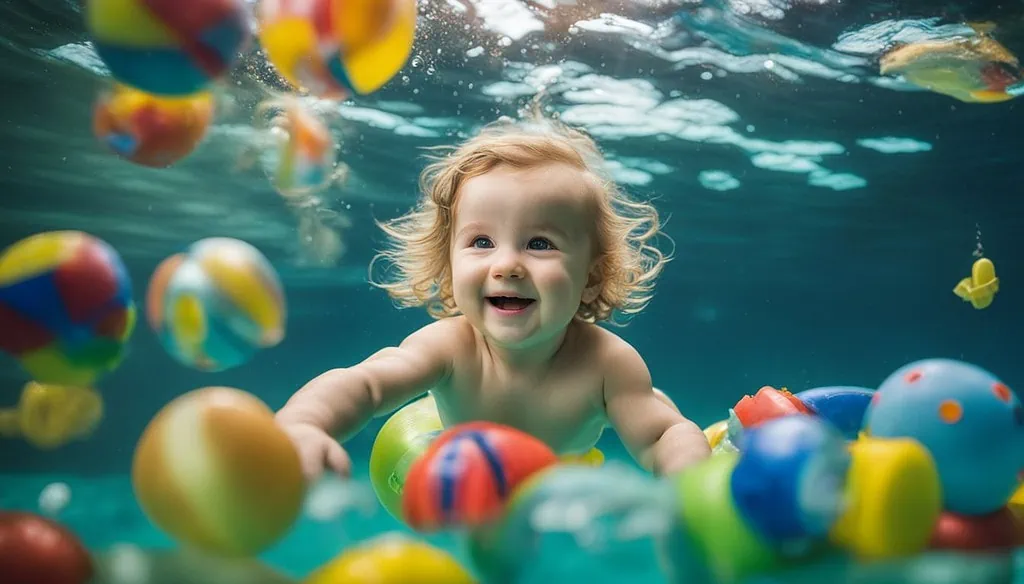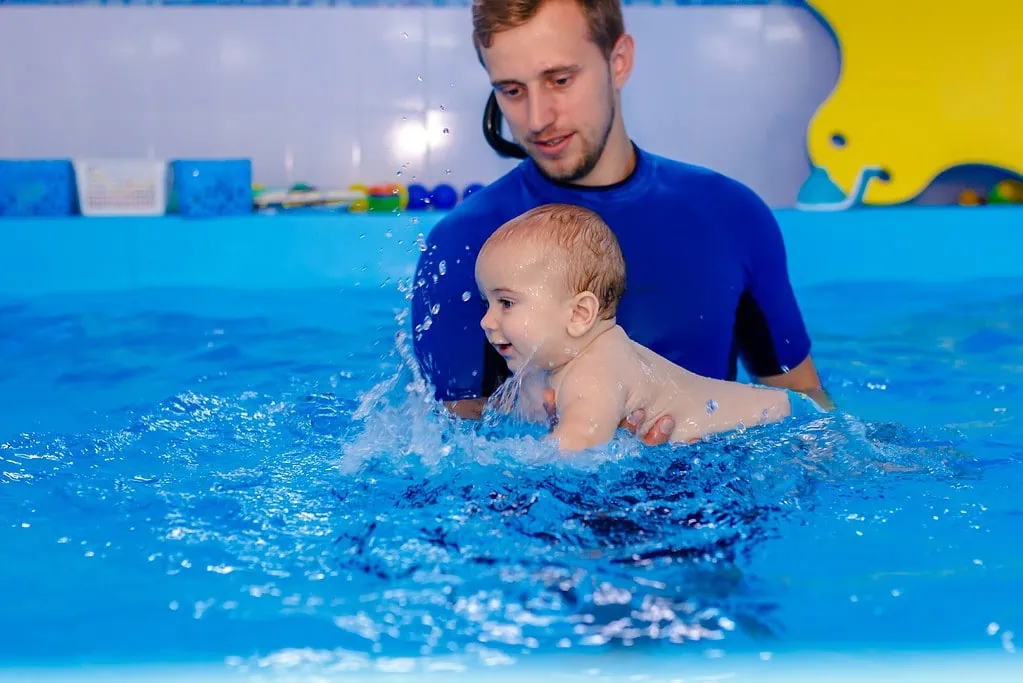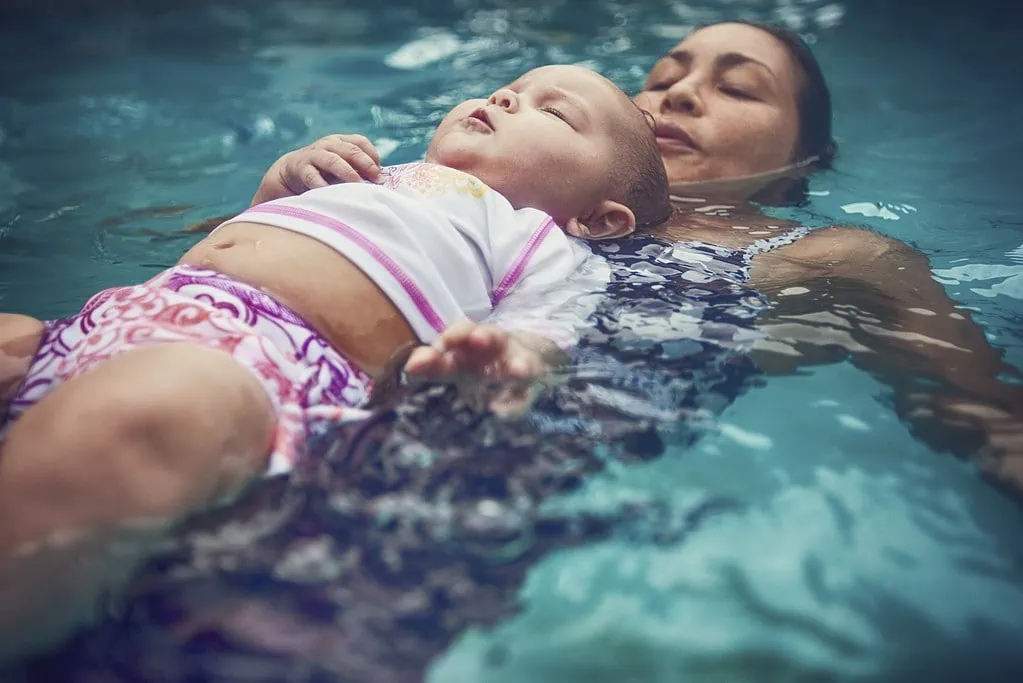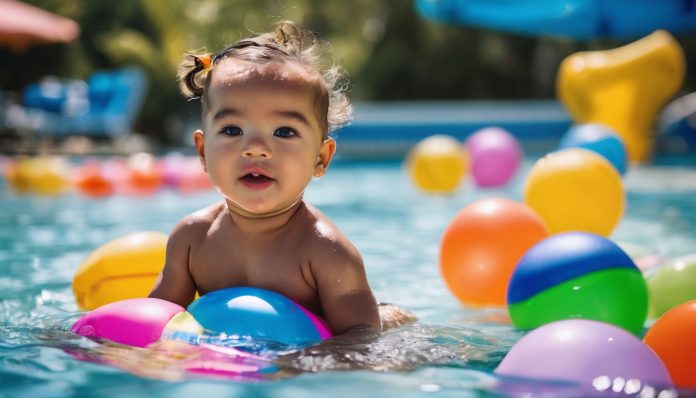Have you ever found yourself gazing at the pool, pondering when your darling little one could safely embrace the adventures of underwater exploration? Trust me, you’re not alone. I’ve walked in those nervous parent shoes and desired nothing but for my child to relish water-based activities securely like many others before us.
Curiosity led me to an extensive research quest into intriguing topics such as infant diving reflexes and suitable swimming programs for different ages. This article collates expert insights on the perfect age for babies to venture underneath the water surface, necessary safety measures, and how we can transform their aquatic journeys into joyous yet secure escapades.
Let’s dive in! (I couldn’t help it)
Key Takeaways
- Babies can safely go underwater at around 6 months. This is when their ‘diving reflex’, a natural mechanism that stops water from getting into their lungs, works best.
- It’s important to introduce your baby to water slowly. Start with splashes during bath time, try shallow water play, and finally move on to partial submersions.
- Swimming helps babies with physical development and sensory growth. It increases their confidence in water, lowers the risk of drowning, and strengthens the bond between parent and child.
- Always be within arm’s reach during any water activities involving your baby. Learn safe methods of submerging them underwater – gradually introducing them to this new environment without causing distress is key!
Age Guidelines for Submerging Babies

Many often wonder – what age can babies dip underwater? Experts typically suggest waiting until your baby is around 6 months. Why so? This is when the ‘diving reflex‘, a natural response in infants preventing water from entering their lungs, peaks.
However, remember to always consult with a pediatrician before immersion of young infants due to potential risks and unique medical circumstances.
The diving reflex and its peak age range
The diving reflex is an innate occurrence that even infants experience. This reflex comes into play when your little one’s face hits the water, causing a decrease in heart rate and redirection of blood flow to essential organs for protection.
It’s an astonishing mammalian physiology mechanism where babies naturally hold their breath underwater, protecting their airways from water inflow. Although every baby has this built-in survival instinct, it peaks around six months old before gradually diminishing as they grow older.
Therefore, experts often suggest this age range to introduce submersion experiences carefully under proper supervision for safer aquatic practices.
Recommendations from experts
Experts associated with age guidelines for submerging babies offer valuable insight. They suggest waiting until infants are at least two months old before introducing them to water.
This precaution helps prevent potential infections, ensuring baby safety. For babies under one year, specialized resuscitation procedures come into play, which contrasts the methods used for older children.
Beyond this initial stage, experts advocate starting water survival skills training as soon as feasible. Early swimming lessons can commence from age one, and research indicates that such early involvement could substantially decrease drowning risk later in life.

It’s a proactive approach to infant drowning prevention that promises immediate and long-term rewards.
Risks and precautions for very young babies
Safety measures abound when it comes to submerging very young babies in water. Under two months of age, a baby’s immune system is still developing, which leaves them more susceptible to infections from bacteria present in swimming pools or other bodies of water.
It’s advisable to hold off on their first swim until they reach this age milestone.
Incorrect submersion methods can pose extreme dangers for infants under one-year-old. These vulnerable little ones may not voice complaints or exhibit clear signs of discomfort, making it paramount for adults to take extra care.
Ensure appropriate support and supervision are provided during any underwater activity involving your young child.
Benefits of water for babies
Allowing babies in water can greatly boost their confidence and help them develop safety skills early. This practice also stimulates physical development and heightens sensory perception, contributing to overall growth.
It’s not just about the fun or cool photos; it’s a unique opportunity for bonding and building trust between parent and baby that enriches emotional connection.
Enhancing water confidence and safety skills
Teaching your baby to swim is more than just a fun activity. It’s an essential step towards instilling water confidence and safety skills. Submerging babies underwater aids in honing their aquatic locomotor abilities while also promoting a sense of self-assurance within the water environment.
In fact, it’s such an effective method that many experts recommend beginning these lessons as early as one year of age. This fosters independence and significantly decreases the risk of drowning, which can be a grave concern for parents.
However, remember timing differs for each child, so patience during this process is critical to building up their trust in navigating through water successfully on their own.
Stimulating physical and sensory development
A magical thing happens when you introduce your baby to water. Water immersion stimulates their tiny senses in a brand-new way. The gentle resistance of the water, along with its unique buoyancy, offers an exciting world for babies to explore and engage with.
As they kick their legs or wiggle their toes underwater, they are not just having fun but also working on developing crucial motor skills.
Submerging your baby underwater goes beyond physical development; it can also boost sensory growth. Touching and feeling the movement of the water around them helps newborns become alert and responsive to different sensations around them, fostering an enhanced understanding of their environment.
Aquatic therapy’s immersive nature encourages interaction with both parents and surroundings, nurtures emotional wellbeing, and encourages social interaction from an early age.
Bonding and building trust between parent and baby
Splashing in the water with your baby is more than just fun. It is an intimate time when they learn to trust and rely on you for their safety. Your touch, smiles, and encouragement during swimming lessons make them feel secure and loved.

This deepens the parent-child bond, creating a strong foundation of trust at a very early stage in their development. Equally important is that these joyful water experiences stimulate neuron creation as your little one kicks and glides, simultaneously enhancing physical coordination and brain growth.
Indeed, water activities provide an engaging environment for babies to connect with parents while also playing a significant role in their cognitive advancement.
Safe Practices
Discover ways to safely introduce babies to the water, ensuring their comfort and safety during this exciting new experience. Learn how gradual exposure, proper support, supervision, and proven techniques can make underwater experiences safe and fun for your little one.
Continue reading to gain insights into these essential precautions that all parents should know.
Gradual introduction to water and submersion
Introducing your baby to water should be a gradual, carefully supervised process. Here’s how:
- Start with Sprinkles: Shower little droplets on your baby’s skin during bath time. This familiarizes them with the sensation of water.
- Shallow Water Play: Allow your infant to splash around in shallow water. Baby tubs or kiddie pools are perfect for this.
- Get into the Water Together: Join your infant in the water to help build their confidence and comfort around you.
- Introduce Submersion Slowly: Once they’re ready, slowly submerge parts of their body, starting with the feet and working up to their head last.
- Use Toys: Engage them in play using floating toys which can distract and ease any potential fear.
- Safety is Paramount: Always stay within arm’s reach when your baby is near or in the water.
- Follow Structured Swim Lessons: Consider enrolling your child in structured swim lessons where aquatic skills are introduced professionally once they are two months old, per ACFASP guidelines.
Proper support and supervision
Taking the plunge with your child involves rigorous attentiveness on your part. As a guardian, it’s fundamental that you’re not only right there in the water but also actively engaged in providing proper support and supervision during water play.
Even an inch of water can pose risks to little ones if we are not vigilant.
I insist on staying within arm’s reach while my child explores underwater adventures. In fact, I have found this proximity allows me to react quickly and lends comfort to my child as they develop their swimming skills and confidence around water.
Let’s not forget that infant swimming lessons or survival skill training by professionals can be highly beneficial; however, these classes never replace our crucial role as parents in ensuring safety at all times.
Techniques for submerging babies safely
Ensuring your baby’s safety when introducing them to underwater activities requires careful implementation of certain techniques. Here are several methods that you can employ:
- First, understand the diving reflex in babies. Babies possess an instinct known as ‘reflex bradycardia‘, which allows them to hold their breath and open their eyes when submerged underwater.
- Gradually introduce your baby to water. Begin by splashing warm water on their body before gradually dipping them into the water with proper support and supervision.
- Maintain optimal water temperature. Young babies need warm water during swimming sessions to prevent chill and potential infections.
- Support your baby properly while submerging them underwater. Always provide physical assistance to ensure safety.
- Avoid survival swim training methods that repeatedly submerge babies underwater, as these practices might distress your baby and compromise their comfort and well-being.
- Teach your baby aquatic breathing and natural swimming instincts through gentle, guided practice in the water.
- Be alert for signs of distress or discomfort from your baby during any underwater activity and immediately end the session if such signs occur.
Conclusion
Embracing the magic of water can be an exciting chapter in your baby’s life. As they get familiar with this new environment, their strength, confidence and survival skills are set to blossom.
You can introduce submersion techniques early in your life with careful planning and vigilant supervision. This aquatic journey navigates towards enhanced physical development while fostering a lifelong love for swimming.
FAQs
1. At what age can a baby safely go underwater?
A baby can safely go underwater from about six months old, when they have good head and neck control.
2. Is it dangerous for babies to go underwater?
If supervised properly, it’s generally safe for babies to go underwater in controlled environments, but always consult with your pediatrician first.
3. Can a newborn baby swim underwater?
Newborns should not be submerged in water as their reflexes and physical abilities are still developing.
4. What should I do if my baby accidentally goes underwater?
If your baby accidentally goes underwater, lift them out immediately and make sure they are breathing normally; contact a healthcare professional if you’re unsure.
5. How long can babies stay under the water?
Babies shouldn’t remain submerged for too long — usually, only a few seconds is enough – and you should never leave them unattended while in the water.
